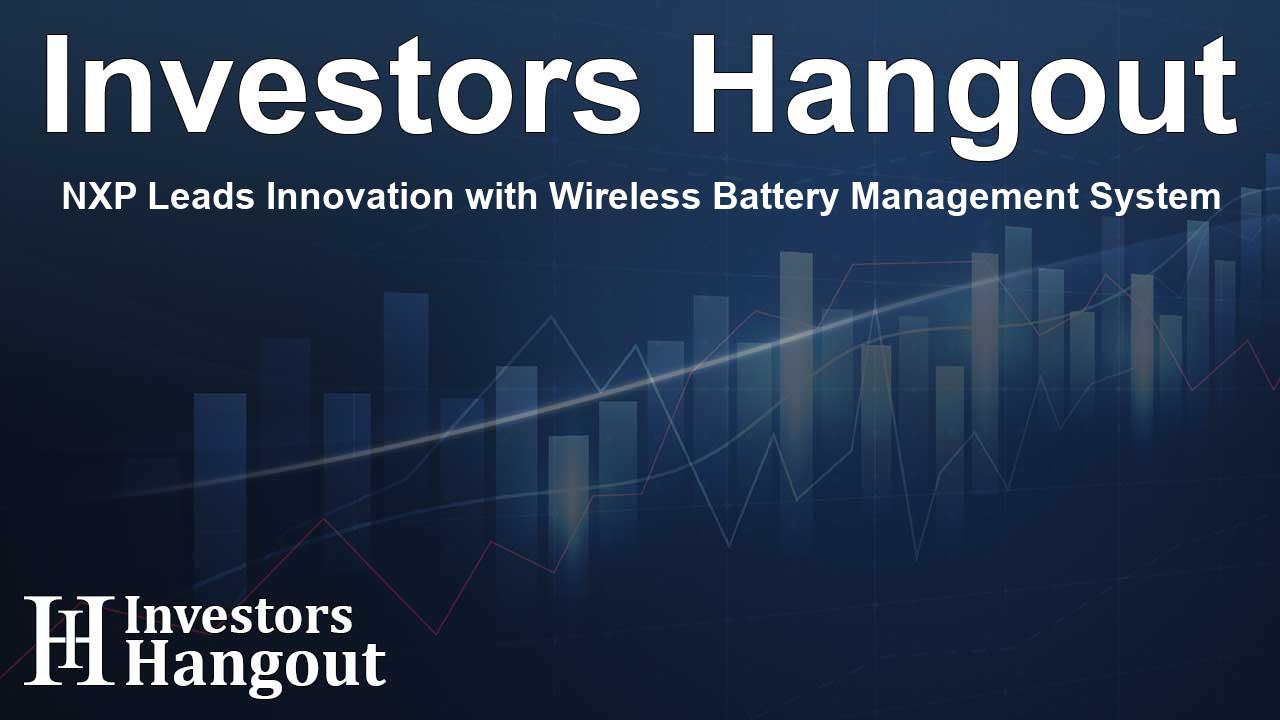NXP Leads Innovation with Wireless Battery Management System

NXP Unveils Revolutionary Wireless Battery Management System
NXP Semiconductors N.V. (NASDAQ: NXPI), a leader in automotive solutions, has announced an innovative wireless battery management system (BMS) that utilizes Ultra-Wideband (UWB) technology. This groundbreaking system simplifies the assembly of electric vehicles (EVs) and enhances battery energy density, ultimately playing a critical role in the evolution of electric mobility.
Transforming Electric Vehicle Assembly
The introduction of NXP's UWB wireless BMS is a remarkable advancement in the automotive sector. This technology not only helps reduce the complexity involved in battery management but also allows for the decoupling of mechanical and electrical components during development. As a result, manufacturers can achieve a more streamlined production process, expediting the time it takes to bring EVs to market.
Enhanced Data Transfer with UWB Technology
One of the standout features of NXP's BMS is its ability to facilitate robust data transfer between battery modules and the management system. The UWB technology is designed to withstand the challenges posed by reflections and fading, which are common issues encountered with traditional narrow-band systems. This ensures that vital information—such as voltage levels and temperature readings—is transmitted accurately and reliably, reducing the risk of performance issues and safety hazards in the battery.
Increased Energy Density for Greater Performance
A key advantage of adopting NXP's wireless battery management system is the significant increase in energy density achieved by minimizing the use of cumbersome wiring and connectors. By eliminating these physical connections, the battery pack can support a higher energy capacity without compromising performance, which is essential for extending the range of electric vehicles.
Benefits for Original Equipment Manufacturers
For manufacturers, the integration of NXP's UWB technology into their battery management systems translates into lower development costs and enhanced flexibility. The FlexCom chipset, which offers compatibility with both wired and wireless configurations, simplifies the vehicle architecture by allowing manufacturers to reuse software and libraries across various platforms. This compatibility aids in accelerating the design process while maintaining rigorous safety standards.
Strategic Advantages in the Evolving Automotive Market
NXP's pioneering approach in the automotive segment leverages the growing demand for electric vehicles. As automakers increasingly look to innovate and differentiate their products, the flexibility and scalability of NXP's wireless BMS positions them as a vital partner in this transformative industry. By embracing advanced technologies like UWB, manufacturers can enhance vehicle functionality while reducing costs associated with complex wiring and production challenges.
Overview of NXP’s Electrification Solutions
NXP's commitment to the electrification of transportation is reflected in its comprehensive solutions that address energy management across various domains. From electric vehicles to smart grids, NXP empowers manufacturers to optimize energy flow and enhance system performance. Their solutions include everything from battery cell controllers to battery junction boxes, ensuring that OEMs can achieve the efficiency and safety required in today’s competitive landscape.
As NXP continues to innovate, it remains dedicated to delivering cutting-edge technology that meets the rapidly changing demands of the automotive industry, reinforcing its status as a trusted partner.
Frequently Asked Questions
What is the main advantage of NXP's wireless BMS?
The primary advantage is its ability to simplify EV assembly while increasing battery energy density and ensuring reliable data transfer with UWB technology.
How does UWB technology enhance data transmission?
UWB technology provides higher resistance to reflections and selective fading, resulting in more reliable communication between battery modules and the management system.
What does the FlexCom chipset offer OEMs?
The FlexCom chipset supports both wired and wireless battery management configurations, allowing for greater flexibility and reduced development efforts.
What is NXP's focus in the electrification market?
NXP focuses on optimizing energy flow in electric vehicles, homes, and smart grids, providing complete solutions for enhanced driving range and performance.
When will the UWB wireless BMS be available for OEMs?
The wireless battery management system solution is expected to be available for OEM evaluation and development in the second quarter of 2025.
About The Author
Contact Olivia Taylor privately here. Or send an email with ATTN: Olivia Taylor as the subject to contact@investorshangout.com.
About Investors Hangout
Investors Hangout is a leading online stock forum for financial discussion and learning, offering a wide range of free tools and resources. It draws in traders of all levels, who exchange market knowledge, investigate trading tactics, and keep an eye on industry developments in real time. Featuring financial articles, stock message boards, quotes, charts, company profiles, and live news updates. Through cooperative learning and a wealth of informational resources, it helps users from novices creating their first portfolios to experts honing their techniques. Join Investors Hangout today: https://investorshangout.com/
The content of this article is based on factual, publicly available information and does not represent legal, financial, or investment advice. Investors Hangout does not offer financial advice, and the author is not a licensed financial advisor. Consult a qualified advisor before making any financial or investment decisions based on this article. This article should not be considered advice to purchase, sell, or hold any securities or other investments. If any of the material provided here is inaccurate, please contact us for corrections.
